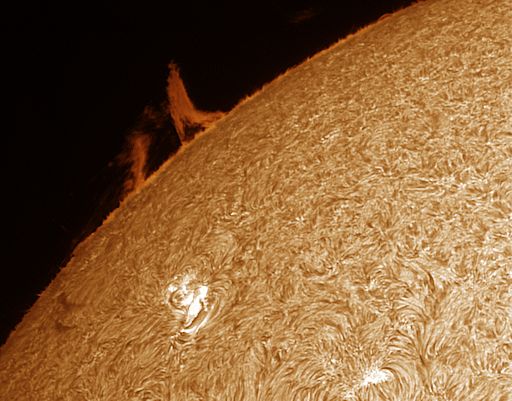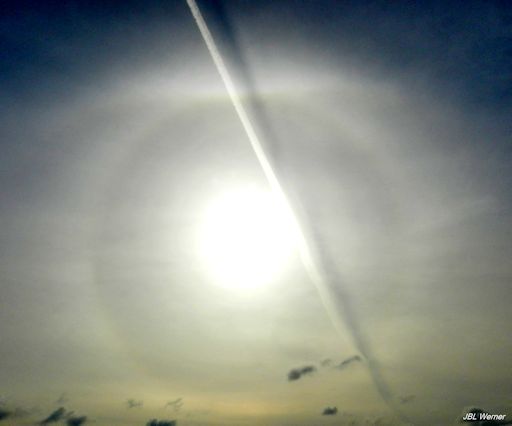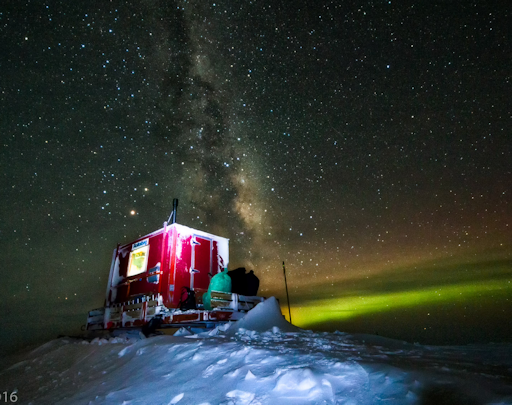Looking for a unique Mother's Day gift? How about Space Roses? Proceeds from the sale of these far-out blooms support student space weather research. | | | SOLAR SECTOR BOUNDARY CROSSING (UPDATED): On April 29th or 30th, Earth will cross a fold in the heliospheric current sheet--a vast wavy structure in interplanetary space separating regions of opposite magnetic polarity. This is called a "solar sector boundary crossing," and it could trigger geomagnetic activity around Earth's poles. NOAA forecasters estimate a 40% chance of G1-class geomagnetic storms on April 29th. Aurora alerts: text or voice WHAT'S AROUND THE BEND? The face of the sun is dotted by small, quiet sunspots. A more active region may be just around the bend. On April 26th, Jack Newton of Osoyoos, British Columbia, photographed plumes of hot magnetized plasma rising over the sun's northeastern limb: 
"The sun is active," says Newton. Indeed, these flame-like prominences could herald the approach of a new sunspot from the farside of the sun. Got a solar telescope? Monitoring is encouraged. Realtime Space Weather Photo Gallery CONTRAIL SHADOWS: Earlier today, a tnetwork ofhin layer of icy clouds passed in front of the sun over Vienna, Austria. Immediately, a bright ice halo surrounded the sun--a result of refraction by the cloud's inner ice crystals. As Jennifer Werner was photographing the display, a plane flew by, bisecting the halo. Look at the picture and answer this question: Is the contrail above or below the clouds? 
Visually, the dense white contrail appears to be underneath the clouds. But the contrail's shadow tells a different story. In fact, the contrail is above, casting its shadow on the clouds below. Where the shadow steals sunlight from the ice crystals in the cloud, the circular halo vanishes. Not everything in the sky is as it seems. More examples may be found in the realtime photo gallery: Realtime Space Weather Photo Gallery PENGUINS SERENADE AURORAS: As northern summer approaches, the midnight skies of the Arctic Circle are no longer completely dark. Aurora season is therefore shifting from north to south. For the next four months or so, the velvety-dark skies of Antarctica are the perfect backdrop for auroras. Penguins on the Brunt Ice Shelf serenaded this display on April 16th: 
"I camped out in the field, enduring temperatures around -32°C to -34°C to witnessthis fantastic glow of green and purple," says photographer Greig Lawson. "This is at the site of an Emperor penguin colony. The calls of the birds in the background provided the soundtrack to the evening's photography!" Lawson is a medical doctor working at the British Antarctic Survey's Halley Research Station. Located atop the Brunt Ice Shelf, a 130 meter thick slab of frozen water that floats atop the Weddell Sea, Halley is known for its studies of ozone, cosmic rays, and climate change. Lawson will be busy in the months ahead tending to the station's wintertime staff of 16. Hopefully, he'll have time send more pictures as geomagnetic storms paint their colors on Antarctic skies. Aurora alerts: text or voice Realtime Aurora Photo Gallery
Realtime Comet Photo Gallery Every night, a network of NASA all-sky cameras scans the skies above the United States for meteoritic fireballs. Automated software maintained by NASA's Meteoroid Environment Office calculates their orbits, velocity, penetration depth in Earth's atmosphere and many other characteristics. Daily results are presented here on Spaceweather.com. On Apr. 27, 2016, the network reported 9 fireballs.
(9 sporadics)  In this diagram of the inner solar system, all of the fireball orbits intersect at a single point--Earth. The orbits are color-coded by velocity, from slow (red) to fast (blue). [Larger image] [movies] Potentially Hazardous Asteroids ( PHAs) are space rocks larger than approximately 100m that can come closer to Earth than 0.05 AU. None of the known PHAs is on a collision course with our planet, although astronomers are finding new ones all the time. On April 27, 2016 there were 1696 potentially hazardous asteroids. Notes: LD means "Lunar Distance." 1 LD = 384,401 km, the distance between Earth and the Moon. 1 LD also equals 0.00256 AU. MAG is the visual magnitude of the asteroid on the date of closest approach. | | Cosmic Rays in the Atmosphere | | Situation Report -- Oct. 30, 2015 | Stratospheric Radiation (+37o N) | | Cosmic ray levels are elevated (+6.1% above the Space Age median). The trend is flat. Cosmic ray levels have increased +0% in the past month. | | Sept. 06: 4.14 uSv/hr (414 uRad/hr) | | Sept. 12: 4.09 uSv/hr (409 uRad/hr) | | Sept. 23: 4.12 uSv/hr (412 uRad/hr) | | Sept. 25: 4.16 uSv/hr (416 uRad/hr) | | Sept. 27: 4.13 uSv/hr (413 uRad/hr) | | Oct. 11: 4.02 uSv/hr (402 uRad/hr) | | Oct. 22: 4.11 uSv/hr (411 uRad/hr) | These measurements are based on regular space weather balloon flights: learn more. Approximately once a week, Spaceweather.com and the students of Earth to Sky Calculus fly "space weather balloons" to the stratosphere over California. These balloons are equipped with radiation sensors that detect cosmic rays, a surprisingly "down to Earth" form of space weather. Cosmic rays can seed clouds, trigger lightning, and penetrate commercial airplanes. Our measurements show that someone flying back and forth across the continental USA, just once, can absorb as much ionizing radiation as 2 to 5 dental X-rays. For example, here is the data from a flight on Oct. 22, 2015: 
Radiation levels peak at the entrance to the stratosphere in a broad region called the "Pfotzer Maximum." This peak is named after physicist George Pfotzer who discovered it using balloons and Geiger tubes in the 1930s. Radiation levels there are more than 80x sea level. Note that the bottom of the Pfotzer Maximim is near 55,000 ft. This means that some high-flying aircraft are not far from the zone of maximum radiation. Indeed, according to the Oct 22th measurements, a plane flying at 45,000 feet is exposed to 2.79 uSv/hr. At that rate, a passenger would absorb about one dental X-ray's worth of radiation in about 5 hours. The radiation sensors onboard our helium balloons detect X-rays and gamma-rays in the energy range 10 keV to 20 MeV. These energies span the range of medical X-ray machines and airport security scanners. | | The official U.S. government space weather bureau | | | The first place to look for information about sundogs, pillars, rainbows and related phenomena. | | | Researchers call it a "Hubble for the sun." SDO is the most advanced solar observatory ever. | | | 3D views of the sun from NASA's Solar and Terrestrial Relations Observatory | | | Realtime and archival images of the Sun from SOHO. | | | from the NOAA Space Environment Center | | | the underlying science of space weather | | 
